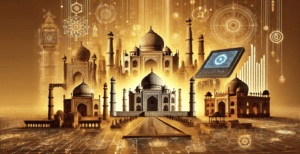Preserving India’s Cultural Heritage Through Technology
India’s rich cultural heritage spans thousands of years, but much of it remains undocumented, making preservation difficult. The National Mission on Monuments and Antiquities (NMMA) is leading efforts to digitize historical sites and artifacts, creating a national database. Over 1.2 million antiquities and 11,400 heritage sites have been documented, with Rs. 20 lakh allocated for the 2024-25 fiscal year. Technologies like 3D scanning, AI, VR, and AR enable immersive exploration and detailed research.
The Indian Heritage in Digital Space (IHDS) initiative enhances engagement through interactive digital experiences and crowdsourced heritage documentation. Strict digitization guidelines ensure high-quality preservation. AI and machine learning will further advance conservation efforts. Integration with education and global heritage initiatives will promote awareness. This digital transformation safeguards India’s past while making history more accessible, engaging, and relevant for future generations.

Preserving India’s Cultural Heritage Through Technology
India boasts a rich and diverse cultural history, filled with ancient monuments, artifacts, and historical landmarks that span thousands of years. From prehistoric relics to colonial-era buildings, the country’s heritage is vast and varied. However, much of this history remains undocumented or scattered, making it challenging to study and preserve effectively. To address this issue, technology is now playing a crucial role in protecting and promoting India’s cultural legacy.
One of the key initiatives driving this effort is the National Mission on Monuments and Antiquities (NMMA). This program focuses on documenting and digitizing India’s historical sites, artifacts, and structures. The goal is to create a well-organized national database that makes this information easily accessible to researchers, historians, and the public. By utilizing advanced digital tools, the NMMA has made significant progress. So far, over 1.2 million antiquities have been digitized, including artifacts from museums under the Archaeological Survey of India (ASI) and other institutions.
Additionally, more than 11,400 heritage sites and monuments have been documented, ensuring their preservation in digital form for future generations. Recognizing the importance of this work, the Indian government allocated Rs. 20 lakh for the project in the 2024-25 financial year.
How Technology is Transforming Heritage Conservation
Modern technologies like 3D scanning, artificial intelligence (AI), virtual reality (VR), and computer vision are revolutionizing how cultural heritage is preserved and studied. High-resolution digital archives allow scholars and the public to explore ancient manuscripts, monuments, and artifacts from anywhere in the world. Virtual reconstructions of damaged or lost historical sites provide an immersive way to experience the past. These tools not only aid in preservation but also make history more engaging for education and tourism.
Virtual and augmented reality (AR) have proven particularly impactful. They enable people to interact with cultural heritage in unprecedented ways. For instance, individuals can virtually walk through an ancient temple or explore a historical site remotely. These technologies also assist researchers in analyzing historical, archaeological, and artistic data in greater detail, uncovering new insights into the past.
The Indian Heritage in Digital Space (IHDS) Initiative
Another significant effort in digital preservation is the Indian Heritage in Digital Space (IHDS) initiative. This program extends beyond simple documentation; it seeks to create interactive and immersive digital experiences that bring India’s history to life. The IHDS initiative also promotes crowdsourcing, allowing individuals and organizations to contribute to a shared digital collection of cultural assets. This collaborative approach ensures the preservation of a wide range of heritage resources and makes them widely accessible.
The IHDS initiative focuses on curating, storing, and distributing multimedia heritage resources, making them available for interdisciplinary research. To maintain high standards, the NMMA has established clear guidelines for digitizing cultural assets. For example, photographs of historical buildings and artifacts must be taken in uncompressed TIFF format with a resolution of 300 dpi. Detailed documentation is stored in Excel sheets, ensuring that researchers can easily access and study the information.
The Future of Digital Heritage in India
As India continues to digitize its cultural heritage, the potential for future advancements is immense. Emerging technologies like AI and machine learning will further enhance the preservation and analysis of historical artifacts and sites. These tools can help identify patterns, restore damaged artifacts, and even predict potential risks to heritage sites. Integrating these digital archives with educational platforms and global heritage initiatives will also make India’s cultural history more accessible to people worldwide.
By leveraging technology to protect and promote its history, India is ensuring that future generations can connect with and learn from its incredible cultural heritage. This digital revolution is not just about preserving the past—it’s about making history accessible, engaging, and relevant in the modern world. Through continued innovation and collaboration, India’s cultural legacy will thrive in the digital age, inspiring people for generations to come.
You must be logged in to post a comment.